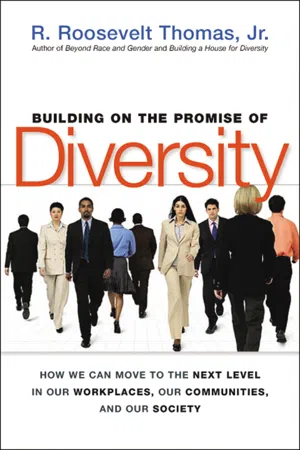
Building on the Promise of Diversity
R. Thomas
- 256 pages
- English
- ePUB (mobile friendly)
- Available on iOS & Android
Building on the Promise of Diversity
R. Thomas
About This Book
This book is an impassioned wake-up call to bring diversity management to a new level -- beyond finger-pointing and well-meaning "initiatives", and toward the shared goal of building robust organizations and thriving communities.
Leading diversity expert R. Roosevelt Thomas, Jr. has has continually raised the bar on how we think and act on a complex array of diversity issues and states that despite good intentions and hard work, most organizations are stuck in their diversity efforts. In our communities and our workplaces, a feeling of frustration has emerged as the promise of the Civil Rights Movement and affirmative action has become overly politicized and polarizing. Managing diversity is not a new issue, however, it is both a hallmark and core challenge that organizations and society have confronted since the founding of America, "an experiment in diversity."
This original, thoughtful, yet action-oriented book will help leaders in any setting -- business, religious, educational, governmental, community groups, and more -- break out of the status quo and reinvigorate the can-do spirit of making things better. The book includes a deeply felt analysis of the tangled intersections between diversity management, the Civil Rights Movement, and affirmative action agendas…and a roadmap for mastering the powerful craft of Strategic Diversity Management™, a structured process that helps you:
- Realize why multiple activities and good intentions are not enough for achieving sustainable progress.
- Recast the meaning of diversity as more than just race and gender, but as any set of differences, similarities, and tensions.
- Accept that a realistic goal is not to eliminate diversity tension but to use it as a catalyst to address key issues.
- Recognize diversity mixtures, analyze them accurately, and make quality decisions amid differences, similarities, and tensions.
- Build an essential set of diversity skills and develop your "diversity maturity" -- the wisdom, judgment, and experience to use those skills effectively.
- Reflect on the ways you might be "diversity challenged" yourself.
Whether you let diversity be a drain on your organization or a dynamic contributor to your mission, vision, and strategy is both a choice and a challenge. Building on the Promise of Diversity gives you the insights and skills you need to navigate through simmering tensions -- and find creative solutions for achieving cohesiveness, connectedness, and common goals.
Frequently asked questions
Information
PART ONE
INTRODUCTION
1

CHAPTER

DIVERSITY
IN SEARCH OF THE NEXT LEVEL

THE POLITICIZING OF DIVERSITY
Implications
Item | Frequency |
Recruitment and retention | 22 |
Constant attention to diversity numbers/metric measures | 17 |
Diversity education, training, and programs | 16 |
Community involvement/philanthropy | 16 |
Supplier diversity | 15 |
Women hired and promoted to higher-level positions | 14 |
Involvement, support, and leadership from CEO/president | 10 |
Rewards, bonuses, or monetary incentives for diversity | 8 |
Mentoring programs | 8 |
Multicultural marketing | 7 |
People of color hired and promoted to higher-level positions | 6 |
Support from managers and senior executives | 5 |
Partnerships with outside organizations | 5 |
Communication between upper-level/lower-level/community/vendors/consumers | 4 |
Emphasis on the individual | 3 |
Hiring of interns of color | 2 |
Hiring of people with disabilities | 1 |
Total | 159 |